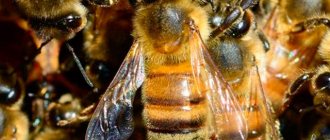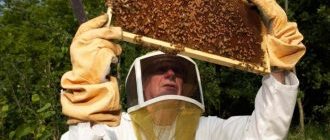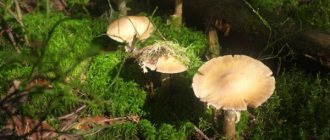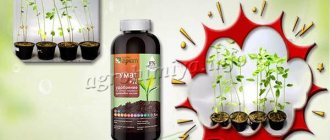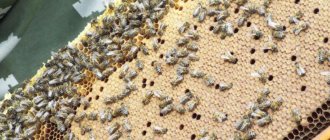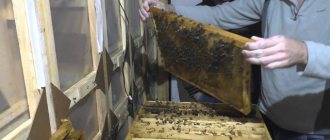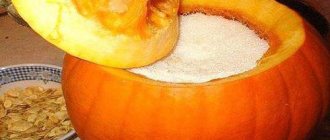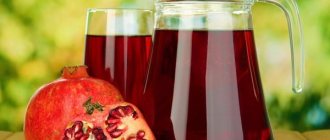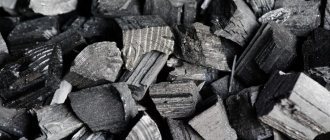Calculation of the amount of feeding
In order to calculate how much sugar syrup you need to make, you need to figure out how much food one family will need for the winter. Thus, the average norms calculated by experienced beekeepers state that:
- For one street of the Dadan frame, about 2 kg of food is needed (with dense placement there will be about 3,000 individuals);
- on the Ruta frame street - about 1.75 kg (with the same placement it will accommodate about 2,500 individuals).
Most of the food should be honey prepared in advance by the bees and left in the hives by the apiary owner. But, up to 30% of the total amount can be replaced with honey, which the bees prepare from sugar syrup.
It must be remembered that the calculation of feeding is made from the weight of sugar, and not from the syrup itself. Those. In order for the bees to prepare a kilogram of sugar honey, they need to be fed a kilogram of pure sugar diluted in water, and not one kilogram of the syrup itself.
Features of feeding
Compared to other fertilizers, syrup causes less diarrhea in insects and is better absorbed.
But it also has several significant disadvantages:
- Lack of protein. Bees need protein and amino acids in winter. If there are not enough of them, protein starvation may occur, and insects will begin to eat pupae and larvae.
- Sweet liquid causes increased excitement in insects and often causes an early exit from hibernation. At the same time, bees begin to fly out of the hives during frosts and actively raise young animals that die in the cold.
- Bees do not eat cold liquids. Therefore, it must be added in portions throughout the winter.
But despite the shortcomings, this is the best option for artificial feeding of bee colonies in winter.
Feeding time
There are three periods when it is best to fertilize the apiary. The first is in the fall: until mid-September. This option is the softest for honey bees, because they will have time to process the solution in the honeycombs before frost. And in winter they will eat regular honey.
The bees will not have problems with lack of food and digestion. It is important for the beekeeper to choose the best time to add sugar to the feeder in the nest. The air temperature should be more than +10 degrees, because only at this temperature does sucrose decompose.
Be sure to read:
Feeding bees for the winter: what they eat, how and when to feed, when feeding is not necessary
But at the same time, feeding bees too early can have a negative impact on the young and cause their exhaustion. The option of autumn feeding is suitable if the bees have their own reserves of honey, but they are not enough for the winter.
The second period is in winter.
In winter it is necessary to fertilize in two cases:
- Adults and brood starve from lack of honey. It can be identified by a sharp decrease in the buzz of the hive.
- Insects have digestive problems and diarrhea due to honey - then the buzzing of the hive intensifies.
In this case, sugar should be added to the frames in small portions. In this case, the insects in the apiary will eat the sugar solution itself, and not process it into honey.
And the third method is for the case when the bees do not have their own supply of honey and need to be fed throughout the wintering period.
What sugar and water is better to use
It is necessary to approach the preparation of syrup very carefully, because a low-quality solution can harm bee colonies more than hunger.
For it you will need:
- Pure non-mineralized water. You can check for the presence of minerals by boiling: if scale and sediment do not appear, then the water is fine.
- White sugar, free of impurities , is of high quality because young brood cannot digest impurities.
- Non-oxidizing clean dishes for cooking sugar solution. Stainless steel pans are best.
It is not recommended to use other water and sugar.
How to fertilize?
Feeding bees in the fall can be done in two ways:
- small doses (up to 1 liter);
- in large doses (from 1 to 3 liters per feeding).
The first option is more acceptable, since a small amount of bees will be processed more efficiently. This is due to an enzyme specially produced by bees - invertase. In cold weather, they cannot produce it in the required quantity for high-quality processing of a large volume of sugar syrup, since they are very tired and exhausted during the period of flowering plants and collecting the bulk of honey.
Large doses can be used when there are a large number of bees in the colony and there is already formed good brood.
For feeding, separate wooden feeders, which are installed in the upper part of the hive, or special feeder frames are suitable.
It is best to feed in the evening, after the end of summer. This will help avoid theft, and will also allow the bees to process all the prepared syrup overnight and wait for the next portion.
If you do not have special feeders for feeding bees, you can use a drinker with a glass jar or even use an ordinary plastic bottle with holes pre-drilled in it.
You can also fill empty honeycombs in an unused frame with syrup.
Of course, the best option is still a feeder, since in alternative methods you will have to disturb the nest every time with your manipulations.
The main rule for feeding is to prevent drops of syrup from falling on the hive or the surrounding ground.
Autumn feeding with syrup
Types of syrups
Sugar syrup
There are several types of syrup with which bait is carried out. The choice of syrup and the method of its preparation directly depends on the region where the bees live; the wintering place (winter road, street) is also considered an important factor.
Three main types of syrup:
- sugar (based on water and sugar, with the addition of various auxiliary components);
- inverted (best absorbed by bees, contains natural honey);
- full honey (natural honey diluted with water).
In order for the bees to overwinter well, protein food must be present in the evidence. For these purposes, pollen is placed in the hive.
It is recommended to feed insects exclusively in the evening, after flying around.
When preparing sugar syrup, it is necessary to take into account the end result, that is, it is recommended to calculate how much honey will be obtained from the sugar syrup.
Usually one kilogram of sugar produces the same amount of honey. For normal wintering, the hive should contain 2–3 kilograms of natural honey.
Cooking methods
In order to properly cook the fertilizer, it is recommended to use extra-class white granulated sugar. The water must be filtered; well water will do.
Each beekeeper prepares syrup according to his own recipe, but the optimal solution is a solution of 62–64% concentration.
You cannot dilute the syrup with boiling water; it is recommended to use water brought to a boil. Before feeding, the sugar solution must be slightly warmed to 35–40 degrees Celsius.
Ingredient consumption is presented in the table:
The most popular additives are fir oil, pine syrup and silver water. They have a detrimental effect on ticks and serve as an additional source of protein.
It is recommended to give sugar syrup to bees in two ways. The syrup is poured into special feeders, which are installed at the top of the hive. Feeders are commercially available, but beekeepers can make them themselves.
The second method is to pour the syrup into tight bags. Syrup bags are placed on top of the canvas. It is recommended to pierce the bags in several places.
Inverted syrup is much better absorbed by the digestive system of insects.
Inverted feeding is prepared in several ways: with the addition of honey and replacing it with nutritional supplements.
The inverted solution has a number of advantages:
- less energy is spent on the absorption of syrup;
- after inverted feeding, the “survivability” of bees in the spring increases significantly;
- strengthens weakened families;
- the syrup is not subject to crystallization.
A solution without honey is prepared using 6 kg of sugar and 7 liters of water with the addition of citric acid.
All ingredients are thoroughly mixed and brought to a boil. The finished syrup should cool and brew for 3-4 hours.
Honey-based feeding: it is recommended to add 10% honey from the total mass of the solution to 70% sugar syrup.
The fertilizer is thoroughly mixed and stored in a dark place for 7 days.
Syrup with the addition of Pchelit: mix water and sugar in equal parts, add the drug according to the instructions for use. The breakdown of sugar lasts 48 hours, the temperature should not exceed 45 degrees Celsius.
Honey satiety is the most expensive, but also the most useful of all supplements.
In other words, fullness is honey diluted with water. Thanks to honey nourishment, the number of bees in the family increases, and resistance to disease increases significantly.
The concentration of the solution directly depends on the purpose of feeding. At the end of summer - beginning of autumn, it is recommended to use a thick concentrate. It is prepared at a ratio of 3:1 (three parts honey to one part water).
It is recommended to melt thick honey in a water bath; boiled and cooled water is slowly poured into melted honey. To mix, the components must be heated to 40 degrees.
Cast iron cookware should not be used for making syrups. Enameled, plastic or aluminum containers are suitable.
Additives to syrup
Beekeepers successfully add various additives in the form of herbal infusions and extracts to sugar syrup.
The additives are designed to saturate the bees’ body with nutrients and essential microelements, and increase the vitality and endurance of the bees.
Special medications can also be used for preventive or therapeutic purposes.
The following additives are most popular among beekeepers:
- In order to increase the immunity of bees, cobalt is added to complementary food. Cobalt tablets can be purchased at the pharmacy. As a rule, two tablets are enough for 2 liters of syrup.
- To replenish vitamins and microelements, ordinary baker's yeast is successfully used as an additive. For 5 liters of syrup you need approximately 125 grams. pressed yeast. If you use dry yeast, you must first dilute it with water.
- To avoid bee infections, Fumagillin can be added to sugar syrup. This is the most reliable remedy for combating bee nosematosis, which can be caused by prolonged rainy weather, late flight of bees, etc. It must be diluted strictly in accordance with the attached instructions.
- Pine extract added to sugar syrup will protect hives from mites. Pine and spruce needles are rich in vitamins and phytoncides, which have a beneficial effect on the immune system. Its use increases resistance to infections and has a positive effect on the number of offspring of bee colonies. 2 grams of extract are mixed with half a glass of water and mixed with one liter of prepared sugar syrup. But be careful with this supplement! If the proportions are not observed, there is a risk of increased bee mortality. The amount of extract should be up to 4 grams per 1 liter of finished food!
- The most popular additive among beekeepers remains 80% vinegar essence. 3-4 grams (about 1 tablespoon) are distributed per 10 liters of syrup. There is an opinion that bees prefer slightly acidified syrup, wear out less in the process of digesting it and save energy.
- Bee bread is another favorite additive for feeding bees in the fall. Perga compensates for the substances missing in sugar syrup.
Inverted lactic acid syrup
Lactic acid is organic and is also used to invert sugar.
In order to prepare inverted syrup with lactic acid, you need to take:
- water - 3 l;
- sugar -5.5 kg;
- lactic acid - 10 g.
All components are mixed and heated in a water bath for 30-40 minutes.
Some beekeepers use natural inversion. To do this, take 8 kg of honey and 70 kg of sugar per 20 liters of water. After preparing the syrup, it must be kept at a temperature of about 35 ᵒC for 6-7 days.
If the weather is very hot, then use the sun and wrap up well at night. Light heating is acceptable.
Inverted syrup with citric acid
The debate about which acid to use to acidify sugar syrup also continues.
Opponents of vinegar essence claim that it is better to use citric acid for inversion, since it is it that is involved in the biochemical processes occurring in the insect’s body and cannot cause harm.
How to prepare invert sugar syrup and what proportions are needed:
- sugar - 1 kg;
- citric acid - 2 g;
- water - 1 l;
Procedure:
- dissolve sugar in water;
- put the bowl with the future syrup on heat and bring to a boil;
- add citric acid;
- Continue heating for another 1 hour on the lowest heat.
To prepare inverted syrup correctly, it is better to heat it in a water bath for 2-2.5 hours.
In this case, the process will proceed slowly, but at a stable temperature not exceeding 70 ᵒC, and the results will be the most optimal.
How to feed?
Ready-made food is distributed warm, at least 30 degrees. When cooled, it will not attract insects. Every time you should distribute a freshly prepared mixture, the frequency is two to three days.
Syrup for feeding bees in the spring is served in clean feeders. It is recommended to use top feeders as they have more capacity.
The volume of solution in the feeder depends on the size and strength of a particular bee colony. To prevent insects from flying out of the hives in vain, feeding is carried out in the evening.
In addition to feeders, the following methods are used to supply sweet food:
- the mixture is poured into small jars, which are turned upside down and left in shallow trays;
- Beekeepers often serve syrup in plastic bags, tie them tightly and make small punctures in them.
When to feed and for how long?
It is worth starting feeding when the main feeding period is over, the bees are weakened and there are no flowering plants nearby.
In different regions of the country, fertilizing is carried out with some differences in timing. So, in the southern regions it can last until the beginning of October (if the weather remains good), and in others it should be completed in the first ten days of September, since later feeding weakens the bees: they do not have time to process the syrup before new ones are born. bees, which should not be involved in the processing process.
The main task of the young animals is to survive the winter, to be strong and healthy for the next season.
Also, if the brood is very late, then the new individuals will not be able to complete their first year, as a result of which they will begin to defecate inside the hive, which will cause damage to the honeycombs with honey stored for the winter. The worn-out honeycombs are not suitable for food and the bees will not touch them, thereby reducing the volume of preparations until the next season.
Description
One of the most important issues in beekeeping is the issue of feeding. In the summer, the bees are sufficiently saturated with the nectars of fruit bearing plants, which spring cannot boast of, but even in the summer, before the honey growing begins, they need additional food. During this period, the beekeeper is faced with the question: “What to choose? Sugar syrup or honey sati? And we will answer you: “I’m full of honey!”
This product is as close to natural as possible, so bees willingly absorb it and turn it into reserves, and this type of food will bring more benefits to working insects and, most importantly, will not cause harm. It is important to use natural honey, without any kind of injections.
Honey satiety is honey diluted with water in different proportions. The consistency, method of feeding and the ratio of ingredients depend on the time of year. So, for example, in the spring bees do not require a large amount of moisture, so the ideal honey-water ratio would be 3:1. This type of additional feed is convenient for the apiary owner himself.
A good owner always has a lot of honey, so there should be no problems when cooking. Moreover, it is not necessary to use fresh honey to prepare it; the surplus from last years is also perfect.
What are the other benefits of honey satiety? The beekeeping product that workers put into honeycombs is natural, not as candied as when fed with sugar syrup. On food that is as close as possible to natural food, bees increase their numbers faster, get sick less and survive the winter well.
This type of food is also used to stimulate the queen’s oviposition, in order to obtain a large bee family by spring, which will bring a large amount of nectar in one flight.
Substitute for sugar syrup
Today on the shelves of specialized stores for beekeepers you can find ready-made inverted syrup, i.e. one that does not require bees to break down sucrose, since the drug itself has already been broken down into the necessary components.
As a result of such feeding, the individuals do not wear out as much, and in the spring they look healthier, stronger and ready for harvest.
So far, this product has not gained widespread popularity and widespread use. For the most part, this is due to the fact that experienced beekeepers are already accustomed to ordinary sugar syrup and have become adept at making it in the right proportions, and, as we know, all innovations are very difficult for our people.
Composition and properties
The usual diet for bees consists of pollen and nectar, which they process into bee products. The composition of honey contains only natural ingredients, vitamins and minerals, which are contained in the nectar itself and clean, drinking water. They are extremely important for the life of insects, so a product that is as close as possible to the usual diet serves as a wonderful supplement.
The composition, unlike analogues, contains the correct ratio of microelements: proteins, fats and carbohydrates. For example, sugar syrup contains an excessive amount of carbohydrates and sugar, but the amount of vitamins and minerals is extremely small, so it may not provide the bees with a supply of necessary substances.
As mentioned earlier, honey nourishment supports the vital activity of bees better than its analogues. Thanks to the composition, bees get sick less, survive the winter well and receive the supply of vitamins, minerals and trace elements they need in the correct ratio. The honey product does not harm the health of bees, which cannot be said about sugar syrup, for example. It is very important to have the correct honey-water ratio at different times of the year so that insects receive the necessary supply of nutrients.
Honey is also used to stimulate egg laying by the uterus. This is done mainly in the spring. By spring, the bee colony thins out and in order for them to be able to feed themselves in the following months, they use this type of additional food, because it helps to increase the number of insects.
Autumn gathering of bees
Cases have become more frequent in which bee colonies leave their hives full of honey in mid-autumn. Why is this happening? Maybe the bees have flown to look for a better life, grass that is greener, feeding that is sweeter... But putting the prose aside, it becomes clear that the flight from the hive is not without reason. Unfortunately, the golden minds of beekeeping have been puzzling over this issue for a long time, but cannot say why this happens.
One of the reasons may be poor ecology; bees have nowhere to collect high-quality honey, and therefore have nothing to eat. It is possible that a variety of bee diseases are to blame for the fact that bees are gathering, especially infection with the varroa mite. It is at the beginning of autumn that its birth rate increases, and it reproduces in bee hives. Or maybe they just went to a resort, to warm countries. Why? Who knows, they don’t know how to speak. The most common cause of flight is, as noted above, overfeeding bees in the fall. These are the secrets of beekeeping.
How to feed old honey to bees
Syrup for bees in the fall is an essential product. But in addition to syrup, other substances should be present in the insects’ diet in the fall; this could be honey from past “harvests.”
How to feed old honey to bees:
- Choose a moment when insects almost do not fly, approximately in the second ten days of September.
- When it starts to get dark, take the frames with last year’s honey out into the air.
- Place the frames at a distance of approximately 17 meters from the houses.
- The next day, take out and give the insects frames with last year’s honey at any time of the day.
You can do this for several days in a row until there is nothing left of the sushi.
It is necessary to observe how insects clean the dry land and make sure that they do not make holes in the honeycombs. The frame with the softer honey should be periodically placed upward. Instead, a frame with a solid product is installed, the insects are removed, and the frame is placed to the side.
In the end, only those frames that contain the hardest honey may remain uncleaned. Before giving such frames to the bees for cleaning, they are lightly watered in the evening. Overnight, the honey becomes softer, and insects can easily clean everything up.
How to feed old honey to bees
Feeding with last year's honey can be done not only in autumn, but also in spring. This method is safer, since at this time of year insects will not “rob” each other. However, bees eat worse in the spring than in the fall.
Analogs
The main analogue is definitely sugar syrup.
Sugar syrup is made by beekeepers only when honey supplies are exhausted. Some beekeepers claim that sugar syrup suits the bees better than honey syrup. Honey turns out sweeter and does not crystallize as quickly. Yes, this is the absolute truth. But very sweet honey loses 1/3 of its nutrients, and also increases calorie content. But that's not the main thing.
The insect family itself suffers from improper feeding with sugar syrup. Unscrupulous beekeepers feed bees syrup, often replacing their natural food with artificial food. As a result of this, insects do not have enough vitamins and minerals for normal life, so bees often get sick or die.
In addition, feeding bees with sugar syrup is unprofitable for the beekeeper himself. If we look at the profitability of the apiary and the prices for sugar syrup ingredients, we will get a difference in amounts, the preponderance of which will be in the ingredients.

